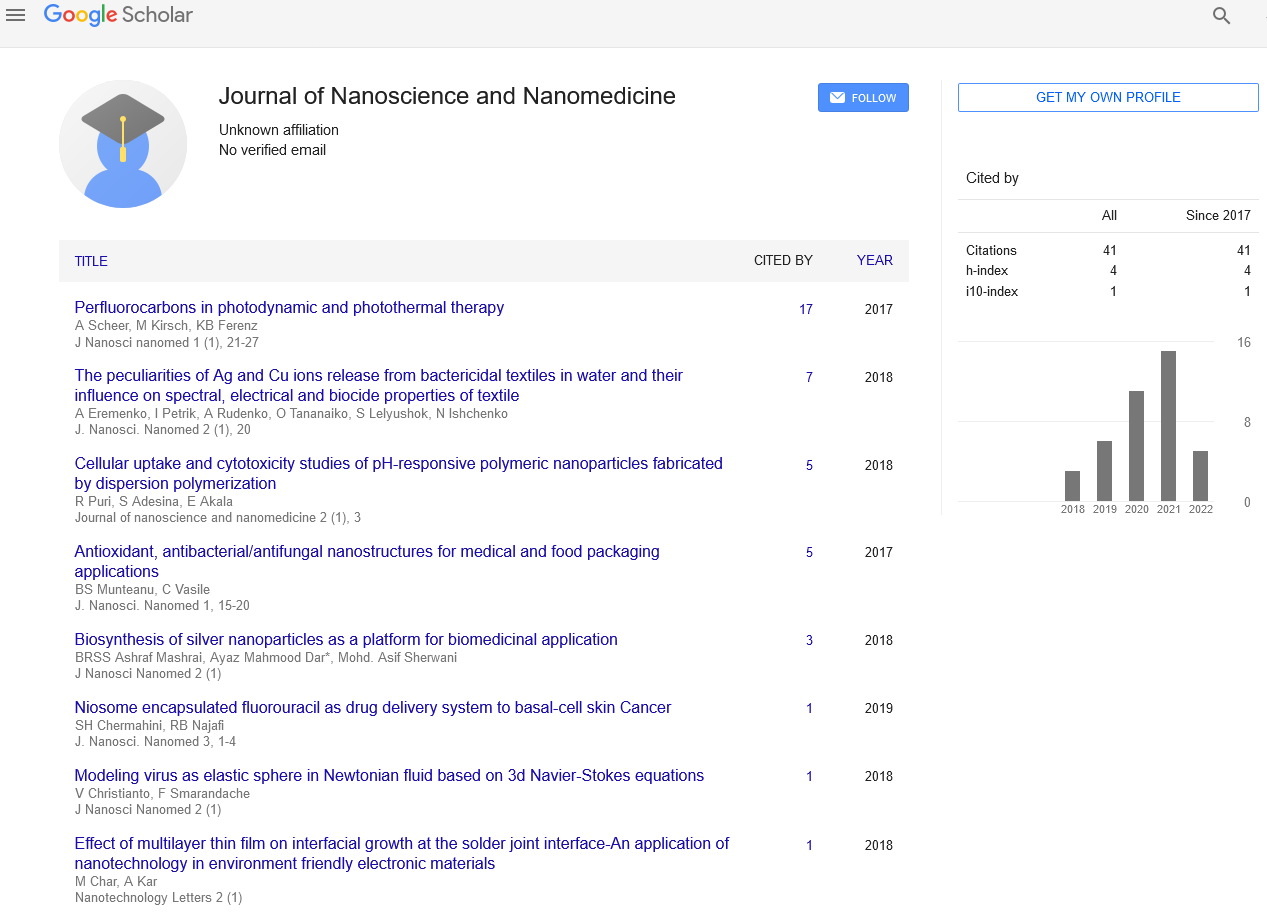A Short Note on Nanostructure based Nano-optoelectronics
Received: 07-Mar-2021 Accepted Date: Mar 17, 2021; Published: 27-Mar-2021
Citation: Gatamaneni A. A Short Note on Nanostructure based Nano-optoelectronics. J Nanosci Nanomed 2021;5(2):5.
This open-access article is distributed under the terms of the Creative Commons Attribution Non-Commercial License (CC BY-NC) (http://creativecommons.org/licenses/by-nc/4.0/), which permits reuse, distribution and reproduction of the article, provided that the original work is properly cited and the reuse is restricted to noncommercial purposes. For commercial reuse, contact reprints@pulsus.com
A nanostructure could be a structure of halfway estimate between minuscule and atomic structures. Nanostructural detail is microstructure at nanoscale. In depicting nanostructures, it is vital to distinguish between the number of measurements within the volume of an question which are on the nanoscale [1]. Metal nanostructures are utilized to improve optical reactions by implies of surface-enhanced spectroscopies such as Raman scrambling, infrared assimilation, and fluorescence spectroscopies. Within the bottom-up approach, nanostructures are created by building upon single molecules or particles. In this strategy, controlled isolation of iotas or particles happens as they are gathered into wanted nanostructures (2–10 nm estimate run).
Nanostructure materials for optoelectronic devices, including light-emitting diodes (LEDs), laser diodes, photodetectors, and sun oriented cells, has as of late pulled in impressive consideration due to their special geometry. Nanostructures in little measurements can be superbly coordinates into a variety of innovative stages, advertising novel physical and chemical properties for the tall execution optoelectronic devices. The misuse of modern nanostructures and their optical and electrical properties is vital for their rising commonsense gadget applications [2]. The utilize of nanostructure materials for optoelectronic gadgets, counting light-emitting diodes (LEDs), laser diodes, photodetectors, and sun powered cells, has as of late pulled in impressive consideration due to their interesting geometry.
A novel nanostructures, later fast advances in investigate including two-dimensional (2D) layered nanomaterials and nanoplasmonics may clear the way for developing next-generation optoelectronic and photonic gadgets. Besides, the utilize of such 2D materials as a buffer layer for the development of light-emitting III-V compound semiconductors by the so-called van der Waals epitaxy strategy has opened up a modern course of heteroepitaxy, moderating a parcel of growthrelated innovative challenges [3].
Unlike the larger part of electronic gadgets, which are silicon based, optoelectronic gadgets are transcendently made utilizing III–V semiconductor compounds such as GaAs, InP, GaN, and GaSb, and their amalgams due to their direct-band hole. Optoelectronic gadgets are electrical-to-optical or optical-to-electrical transducers, or rebellious that utilizes such gadgets in their operation [3]. Optoelectronics is based on the quantum mechanical impacts of light on electronic materials, particularly semiconductors, some of the time within the nearness of electric areas. Optoelectronics is based on the quantum mechanical impacts of light on electronic materials, particularly semiconductors [4]. Optoelectronics concerns the consider and application of electronic gadgets that source, distinguish and control light. Optoelectronic gadgets comprise of distinctive semiconductor amalgams lying on substrates.
Optoelectronic sensors change over light of different wavelengths into an electrical flag. The light in this way discharges electrons from a semiconductor or metal surface, and, on the off chance that there's an outside electric field, the free charge carriers in this way created result in a photometric current corresponding to the concentrated of the light. Whereas Si and Ge are primarily utilized for photo-detectors due to their amazingly moo brilliant proficiency, compound semiconductors are utilized for LEDs and laser diodes due to their tall brilliant effectiveness [4]. An optical sensor changes over light beams into electronic signals. It measures the physical quantity of light and after that interprets it into a shape that's clear by an instrument. An optical sensor is by and large portion of a bigger framework that coordinating a source of light, a measuring gadget and the optical sensor.
The enhanced light extraction effectiveness of LEDs by utilizing two ZnO nanostructures. The tests were performed on two types of nanostructures counting one-dimensional nanorods and two-dimensional nanosheets which were developed directly on beat of LEDs. The arrangement of surface texturing on LEDs with ZnO nanorods offers expanded elude cone and surface scattering, coming about within the upgrade of light output power of 30% compared to customary LEDs without using ZnO nanostructures. Be that as it may, due to the expanded internal reflection and light retention in ZnO nanosheets, LEDs using nanosheet structures have lower light yield efficiency compared to the routine one. The business of ZnO nanorods appears promising approach for the improved output power of LEDs. More critically, Driven gadgets are not severely enduring from debasement of electrical properties by using ZnO nanorods [5-6].
REFERENCES
- Stylianakis MM, Maksudov T, Panagiotopoulos A et al. Inorganic and Hybrid Perovskite Based Laser Devices: A Review. Materials. 2019;12:859.
- Bao Q., Hoh H.Y. 2D Materials for Photonic and Optoelectronic Applications. The Netherlands. 2019;1–336.
- Aslam U, Rao VG, Chavez S et al. Catalytic conversion of solar to chemical energy on plasmonic metal nanostructures. Nat Catal. 2018;1:656–665.
- Noori K, Konios D, Stylianakis MM et al. Energy-level alignment and open-circuit voltage at graphene/polymer interfaces: Theory and experiment. 2D Mater. 2016;3:015003.
- Nguyen HPT, Arafin S, Piao J et al. Nanostructured Optoelectronics: Materials and Devices. J Nano mat. 2016.1-4.
- Viskadouros G, Zak A, Stylianakis M et al. Enhanced Field Emission of WS2 Nanotubes. Small. 2014;10:2398–2403.





